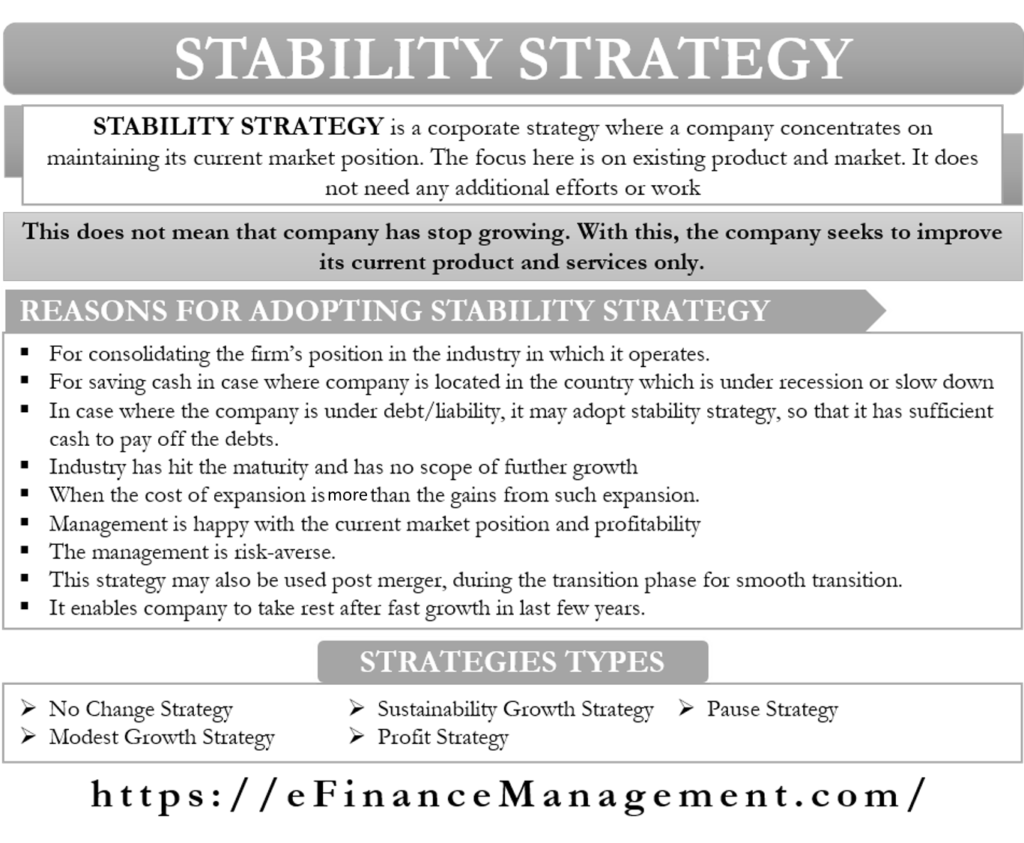A stability strategy is a corporate strategy where a company concentrates on maintaining its current market position. A company that adopts such an approach focuses on its existing product and market. A few examples of this strategy are offering the same products to the same clients, not introducing new products, maintaining market share, and more.
Usually, a company satisfied with its current market share or position uses such a strategy. Also, a company following this strategy does not need any additional resources and work using the existing expertise of the workforce. But, this strategy is useful only if there is a simple and stable environment.
Does a Company Stop Growing?
Following such a strategy does not mean that the company doesn’t strive for improvement. The company here focuses on incremental improvement.
For example, a consumer electronics company focuses on providing better after-sales services to current customers and not on acquiring new customers.
Under the stability strategy, the company usually makes up a plan to move forward either by selling the non-performing segments or by investing in research and development.
Why any Company Adopts Stability Strategy?
Following are the reasons why a company may adopt a stability strategy:
- If a firm plans to consolidate its position in the industry in which it is operating.
- Suppose a country in which the company operates is facing a recession or slowdown. It wants to save cash rather than spend it for expansion purposes.
- If a company has significant debt or loans, then also it may pursue such a strategy rather than going for expansion. Following such an approach would ensure that a company has the cash to pay the interest and principal amount as well.
- The industry in which the firm functions have hit maturity, and there is no more scope for growth.
- Another scenario is when the cost of expansion is more than the gains from it.
- If the management is happy with the current market position and the level of profit achieved.
- Risk-averse management may also favor such a strategy.
- A company can also choose this strategy post-merger. In such a case, this strategy allows a smooth transition of the new entity before the company starts making significant changes.
- This strategy could help a company take a rest following a fast growth in the past few years. Such a tactic allows the company to consolidate the results and resources and plan its next moves.
- Family-owned businesses may decide to slow down in adverse market conditions. They do this to avoid any loss of financial control.

Types of Strategies
Following are the types of approaches to stability strategy:
No-change Strategy
As the name suggests, a company following this strategy does not take up any new activities. Instead, the company continues with its current business. Companies that are well established may go for this strategy.
Modest Growth Strategy
Under this, a company strives to achieve the same target as it did in the past. For example, if a company hit a 5% growth last year, then for the current year also, it targets the same percentage (making adjustments for inflation). It is the most relaxed approach as the risk is low, and the company does not need any additional efforts or resources.
Sustainable Growth Strategy
A company follows this strategy if it believes the external environment is not favorable. For instance, if the economy is in recession or if there is a lack of financial resources.
Profit Strategy
If the objective of a company is to generate cash, then a company may adopt this strategy. A company pursuing a profit strategy may be willing to give up some of its market shares to make cash.
Pause Strategy
A company adopts such a strategy if, in the past, it has enjoyed rapid growth. By using this strategy, the company wants to take some rest before pushing for growth again. Or, we can say, a company moves cautiously for some time before pursuing growth. It is a temporary strategy. A company can use the rest period to make its production more efficient to exploit future opportunities.
For example, Dell used the stability strategy after rapid growth in its e-retailing. Its operations spread to 95 countries, sales hit $2 billion, and the number of employees grew to about 6000. The company had to slow down to restructure its operations at such a time as it was not ready to handle such growth.
Advantages and Disadvantages
Following are the advantages of a stability strategy:
- Adopting this strategy does not disrupt the routine work.
- This strategy is less-risky unless a company faces terrible conditions.
- It allows the company to rethink its long-term strategies.
Following are the disadvantages of the stability strategy:
- Such a strategy is not effective in the long run. In the long run, it could make the company irrelevant or outdated.
- There remains no incentive for any innovation.


This is the best elaboration of the topic…. Thank you
Excellent explanation-S.K.Jha
Thanks a lot. Very informative and easy to read